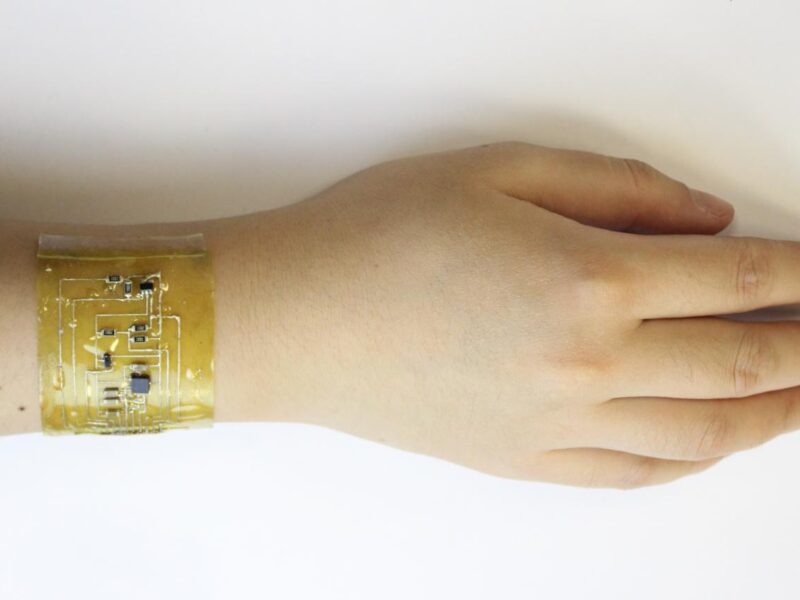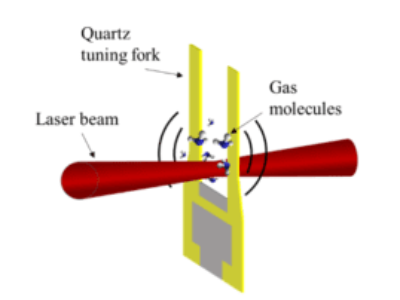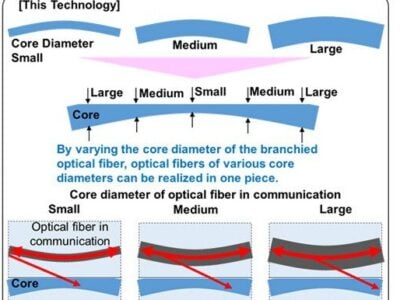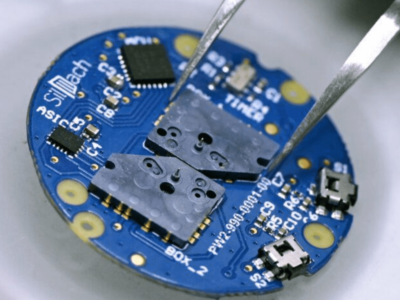
Stretchable circuits for wearable e-skin
The self-healing e-skin developed by Jianliang Xiao and Wei Zhang can, measuring the body temperature of users to tracking daily step counts. It is also reconfigurable so that it can be shaped to fit anywhere on the body.
“If you want to wear this like a watch, you can put it around your wrist,” said Xiao, an associate professor in the Paul M. Rady Department of Mechanical Engineering at CU Boulder. “If you want to wear this like a necklace, you can put it on your neck.”
“Smart watches are functionally nice, but they’re always a big chunk of metal on a band,” said Zhang, a professor in the Department of Chemistry. “If we want a truly wearable device, ideally it will be a thin film that can comfortably fit onto your body.”
Xiao and his team used screen printing to create a network of liquid metal wires. They then sandwich those circuits in between two thin films made out of a highly flexible and self-healing material called polyimine.
The design uses a MCP9700 temperature sensor from Microchip Technology, an ADXL335 triaxial accelerometer from Analog Devices and a ECG sensor using the AD8505 from Analog Devices and resistors from Bourns. The resulting device is a little thicker than a sticking plaster and can be applied to skin with heat. It can also stretch by 60 percent in any direction without disrupting the electronics.
“It’s really stretchy, which enables a lot of possibilities that weren’t an option before,” said Xiao.
The e-skin is also highly resilient. If you slice a patch of electronic skin, Zhang said, all you have to do is pinch the broken areas together. Within a few minutes, the bonds that hold together the polyimine material will begin to reform. Within 13 minutes, the damage will be almost entirely undetectable.
“Those bonds help to form a network across the cut. They then begin to grow together,” Zhang said. “It’s similar to skin healing, but we’re talking about covalent chemical bonds here.”
The e-skin can also be easily recycled in a vat of recycling solution where the polyimine will depolymerize and the electronic components sink to the bottom. Both the electronics and the stretchy material can then be reused.
“Our solution to electronic waste is to start with how we make the device, not from the end point, or when it’s already been thrown away,” Xiao said. “We want a device that is easy to recycle.”
The team’s electronic skin is a long way away from being able to compete with the real thing. For now, these devices still need to be hooked up to an external source of power to work. But, Xiao said, his group’s research hints that cyborg skin could soon be the fashion fad of the future.
“We haven’t realized all of these complex functions yet,” he said. “But we are marching toward that device function.”
Related articles
- SWEAT-POWERED METABOLIC SENSORS WRAP AROUND THE SKIN
- SKIN-WORN HAPTICS GIVES TOUCH BACK TO PROSTHETICS
- EVENT-DRIVEN E-SKIN EASES ROBOTS’ COMPUTE REQUIREMENTS
- SOFT ROBOTIC SKIN PROVIDES BOTH SENSE OF TOUCH AND HAPTIC FEEDBACK
Other articles on eeNews Europe
- Raspberry Pi in keyboard creates first all-in-one PC – video
- 3D printed Millenium Falcon is 100 microns long
- Smart choices in Cree LED deal
- Sondrel tapes out its largest chip
 If you enjoyed this article, you will like the following ones: don't miss them by subscribing to :
eeNews on Google News
If you enjoyed this article, you will like the following ones: don't miss them by subscribing to :
eeNews on Google News



